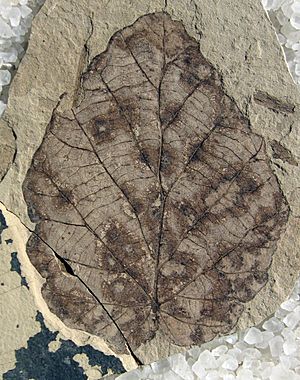Fothergilla malloryi facts for kids
Quick facts for kids Fothergilla malloryi |
|
|---|---|
 |
|
| Fothergilla malloryi specimen | |
| Scientific classification |
Fothergilla malloryi is an extinct flowering plant. It belonged to the Hamamelidaceae family. Scientists know about it from fossil leaves. These leaves were found in northern Washington state. They came from the early Eocene period.
This plant is the oldest known member of the Fothergilla genus. This genus is also called witchalder. Today, living witchalder species like F. gardenii and F. major grow in the southeastern United States. Other fossil species of Fothergilla have been found in Asia and North America.
Discovering Fothergilla malloryi
The fossil of Fothergilla malloryi is a single leaf. It was found in Republic, Ferry County, Washington. This area is part of the Klondike Mountain Formation. This rock formation is about 49.4 million years old. Scientists found its age using a method called Argon–argon dating. The fossil was discovered at a site known as "Boot Hill."
The main fossil specimen for Fothergilla malloryi is called the holotype. It is kept at the University of Washington in Seattle, Washington. Paleobotanists Meghan G. Radtke, Kathleen B. Pigg, and Wesley C. Wehr studied this fossil. Paleobotanists are scientists who study ancient plants.
These scientists published their findings in 2005. They named the plant F. malloryi in honor of V. Standish Mallory. He was a professor at the University of Washington. He made important contributions to studying ancient life in Washington State.
What Fothergilla malloryi Looked Like
The fossil leaf of Fothergilla malloryi is simple and oval-shaped. It is about 4.4 cm (1.7 in) long. At its widest point, near the base, it is about 3.5 cm (1.4 in) wide. The leaf's veins spread out from the main vein. They form a pattern where each vein goes to the edge of the leaf.
The edge of the leaf has large, rounded teeth. Each tooth has its own main vein. F. malloryi was similar in size to the living F. gardenii. It was also similar to the fossil F. viburnifolia. However, it had a different leaf base structure. Other fossil Fothergilla species from Oregon and Japan had different shapes or petiole (leaf stalk) structures.

